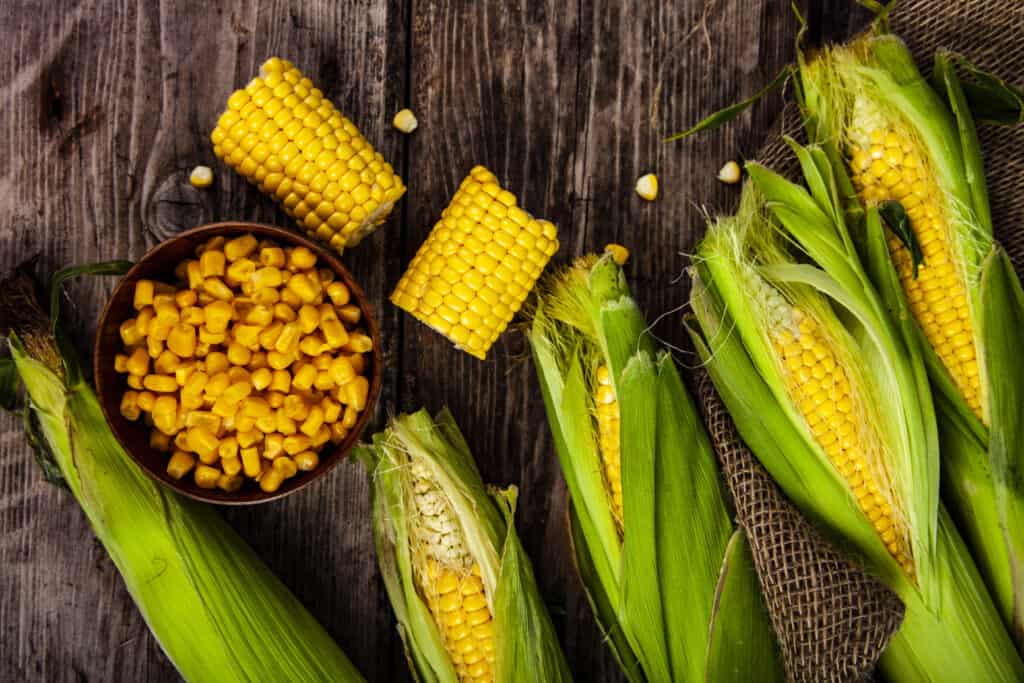The best way to enjoy corn is to serve it within 20 minutes of picking. This is very doable if you are growing your own corn.
But if you do not grow corn or live close to a corn farm, then choose corn that has been picked in the last day or two.
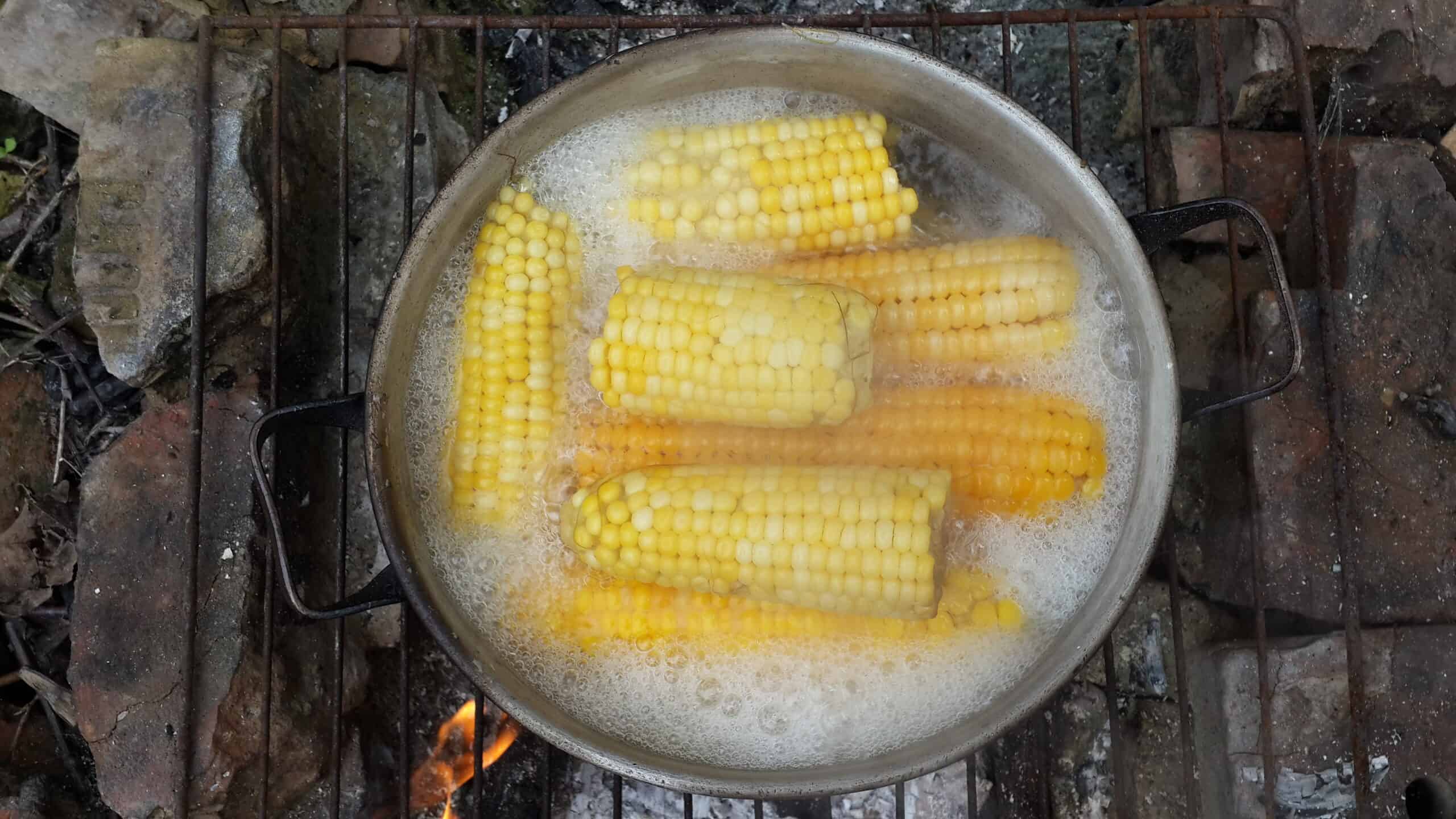
After the corn is picked, its sugars begin a gradual conversion to starch which lessens its natural sweetness. That is why you will enjoy fresh-picked corn the most.
Summer and early autumn are the seasons for fresh corn.
Kitchen Helpers from Amazon:
- Oster Vegetable Steamer
- Chef’s Knives Set of 6
- EZ Off Jar Opener for Weak Hands
- Pepper Core Remover Stainless Steel
- Kitchen Utensils – Set of 35
Favorite sweet corn recipes
Corn Chowder and Summer Flavor
Grilled Corn with Seasoned Butter
Corn serving suggestions
- Cook corn with or without the husk: boil, steam, bake, roast, barbeque, or microwave.
- Corn kernels can be removed from the cob before or after cooking. Raw kernels can be added to soups, mixed with vegetables, stews, and relishes. Cooked kernels can be added to salads, omelets, pasta, risotto, salsa, or soups.
- Mix kernels off the cob with onions, tomatoes, lima beans, pimiento, green peas, mushrooms, celery, or combinations of these.
- Cooked kernels are served as a vegetable side dish or in salads. Allow 20 minutes when steaming corn kernels.
Types of corn
There are hundreds of cultivated varieties of corn. Generally, corn can be classified into three broad categories: sweet corn, popcorn, and field corn, popcorn.
- Sweet corn is the kind of corn that you serve at the table. Sweet corn has pale yellow or white kernels, and is tender, juicy, and sweet. Sweet corn comes on full-sized ears or as baby corn which can be eaten whole.
- Sweet corn on the cob can be steamed, boiled, oven-roasted, and grilled or eaten out of hand without cooking. Sweet corn kernels can be made into corn soup or added to soups, salads, vegetable sautés, fritters, and relishes. Sweet corn also can be creamed and used in puddings or soufflés.
- Sweet white corn is smaller and sweeter than yellow sweet corn. Sweet yellow corn has larger and fuller-flavored kernels.
- Popcorn is a kind of corn whose kernels burst open when exposed to heat. The natural moisture inside the hull of popcorn is what causes popcorn to pop open, turn inside out, and puff out when heated. Popcorn generally has small kernels.
- Field corn is used to feed animals and also is dried for hominy. Hominy grits is ground dried field corn simmered with water or milk until very thick. Field corn is also referred to as dent corn or flint corn. It is low in sugar and high in starch.
How to choose corn
- Select corn with ears that are solid and plump and at least 6 inches (15 cm) long with husks that fit snugly. Husks should cover the entire ear and be green and fresh looking. The stem end should be moist. The silk end should be pale greenish-white and free of decay or worm injury.
- Kernels should be full, plump, and firm and come all the way to the ear’s tip. You can test for juiciness by pressing on a kernel with your fingernail. If the corn is fresh, a milky juice will squirt out. The rows should be tightly spaced.
- Late-season varieties often have larger kernels and a sweeter flavor than early varieties.
- Avoid corn that has discolored or shriveled kernels or has wormholes. Dark and dried corn silks and dull or yellowed husks are a sign the corn is not fresh.
- Avoid corn sold on displays exposed to direct sunlight or high temperatures. Heat accelerates the process of converting sugar to starch.
- Baby Corn. Baby corn is corn harvested before it has matured. Baby corn is ready for harvest just before or just as the silks emerge. Eat baby corn whole, pickled, or use in salads or Asian cuisine.
How to store corn
- Sweet corn will keep in the refrigerator for 2 to 4 days. First plunge the freshly picked ears into ice water to slow the conversion of sugar in the kernels into starch. This will help preserve the sweetness.
- Store corn in its husk in a plastic bag in the vegetable drawer of the refrigerator.
- Sweet corn can be stored in the freezer for 3 to 6 months: blanch on the cob; plunge into an ice bath; cut the kernels from the cob, and freeze.
How to prepare corn
- Strip off the husks and silks just before cooking.
- Shucking corn: Start at the small end of the cob and pull down a portion of the husk toward the stalk end. Repeat until the husk is removed. Once the husk is removed, use your fingers or a vegetable brush to pull away as much of the silk as you can.
- Remove kernels from the cob using a sharp knife or a gadget made for removing kernels.

Corn cooking tips
- Boil or steam corn quickly after picking and spread with plain butter or spice- or herb-flavored butter or olive oil.
- Cook corn on the cob in slightly sweetened water leaving a bit of husk and adding a little milk or beer to the cooking water. Immerse the ears in boiling water and cook for 3 to 4 minutes for small ears and 5 to 7 minutes for larger ears.
- Boil corn on the cob in unsalted water for 6 minutes. Do not let the corn sit in the kettle of water after boiling. It will become soggy. Boiled corn that is not served immediately should be drenched in cold water at the end of boiling (to stop the kernels from cooking further), wrapped in aluminum foil, and reheated in the oven just before serving.
- Do not salt the water and do not overcook corn; both will cause the corn to harden and lose flavor.
- Simmer corn on the cob in unsalted water. Put the corn in just enough liquid to cover it and then bring it to a rolling boil; cover the pot and turn off the heat; allow the corn to simmer-cook in the water for 15 minutes.
- To flavor corn as it cooks add sugar, milk, broth, butter, or margarine.
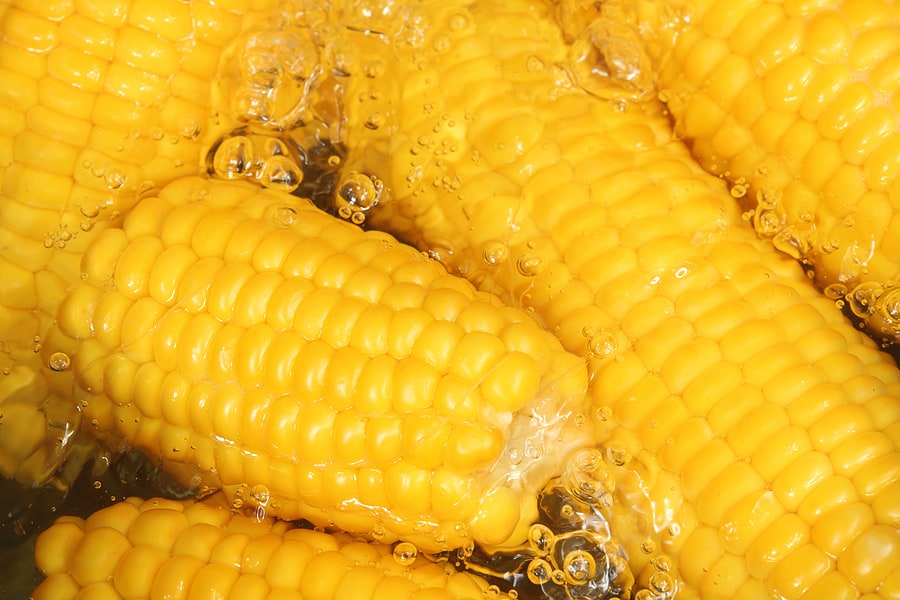
How to boil corn on the cob (preferred method at corn parties)
- Strip off the outer leaves, leaving 2 to 3 inches of stalk on the ear, and pull off the “silks” or tassels.
- Place a large pot of water on to boil.
- Rush to the garden plot and select the perfect ears—creamy and solid with little pearl kernels at the tips.
- Rush back to the kitchen and strip off the husks and rush the corn into the kettle.
- Let the corn boil 6 minutes then heap it on a platter, with a mound of butter. Have a big salt shaker nearby.
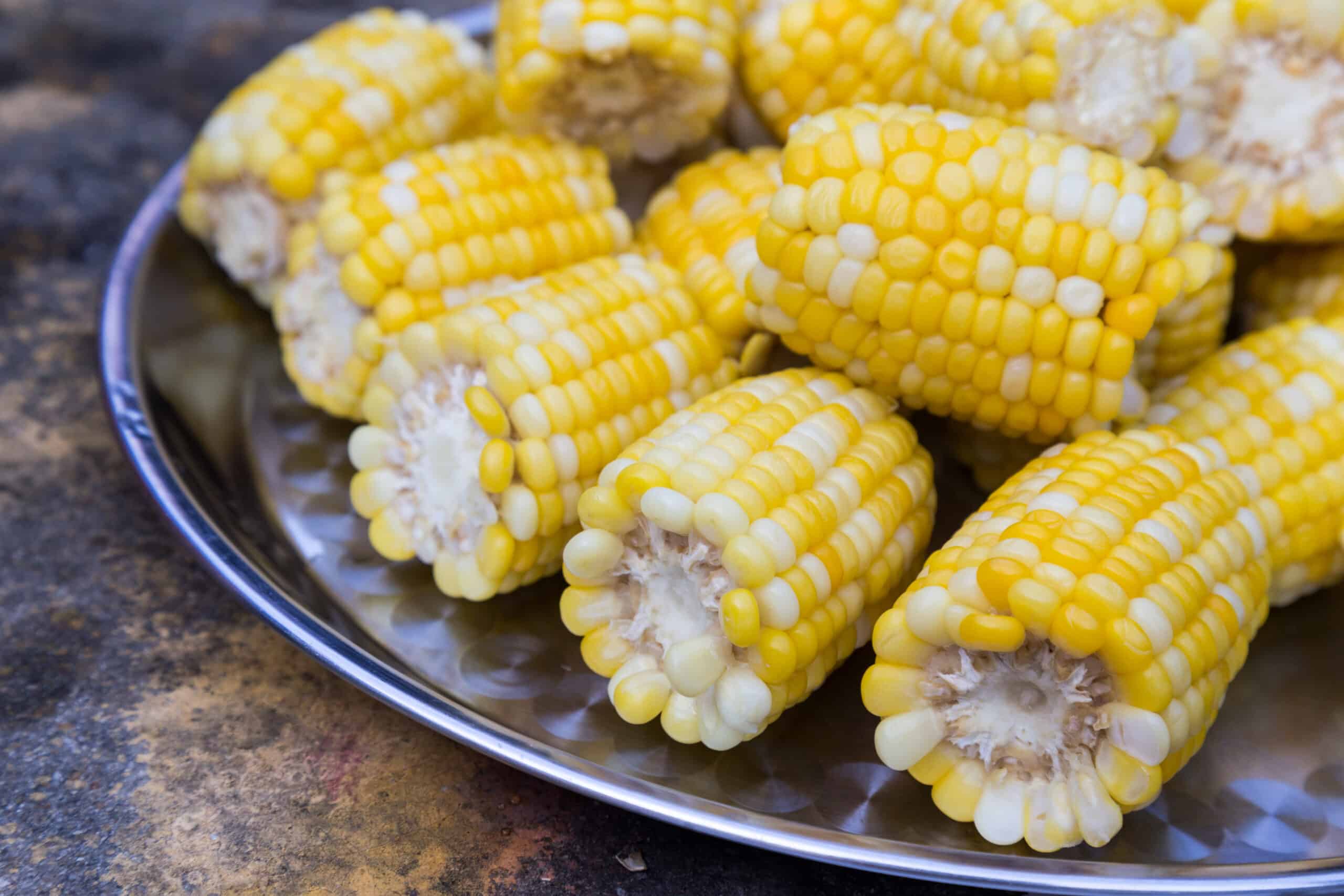
How to steam corn on the cob
- Strip off the husks, leaving 2 to 3 inches of stalk on the ear, and pull off the “silks” or tassels.
- Place two inches of water in a large pot and lightly salt the water.
- Place a steam basket in the pot; be sure the water does not touch the basket.
- Cover and cook over high heat until the corn is just hot, anywhere from 3 to 10 minutes depending on how hot the water is.
- Serve the corn with salt, pepper, and butter to taste.
How to sauté corn off the cob
- Husk the corn and remove the silk.
- Cut the corn kernels from the ears with a very sharp knife.
- Scrape all of the mild and sugar from the cob.
- Melt butter in a pan over medium heat.
- When the butter is bubbling, place the kernels in the pan and sauté gently until the corn is cooked through about 4 minutes. Shake the pan several times so the corn does not stick.
- Add pepper in the last minute of cooking.
- Spoon the corn into a heated serving dish and add salt.
Sauté variations
- Add heavy cream to the corn about halfway through cooking and heat well.
- Before adding the corn sauté a medium-sized green pepper until soft and tender; then add the corn.
- Sauté a chopped onion place the sautéed onion along with peeled, seeded, and chopped tomato and a seeded and finely chopped chili, and the corn into a greased baking; sprinkle lightly with chili powder and bake for 45 minutes at 350 degrees F; 10 minutes before it is done sprinkle with grated jack cheese.
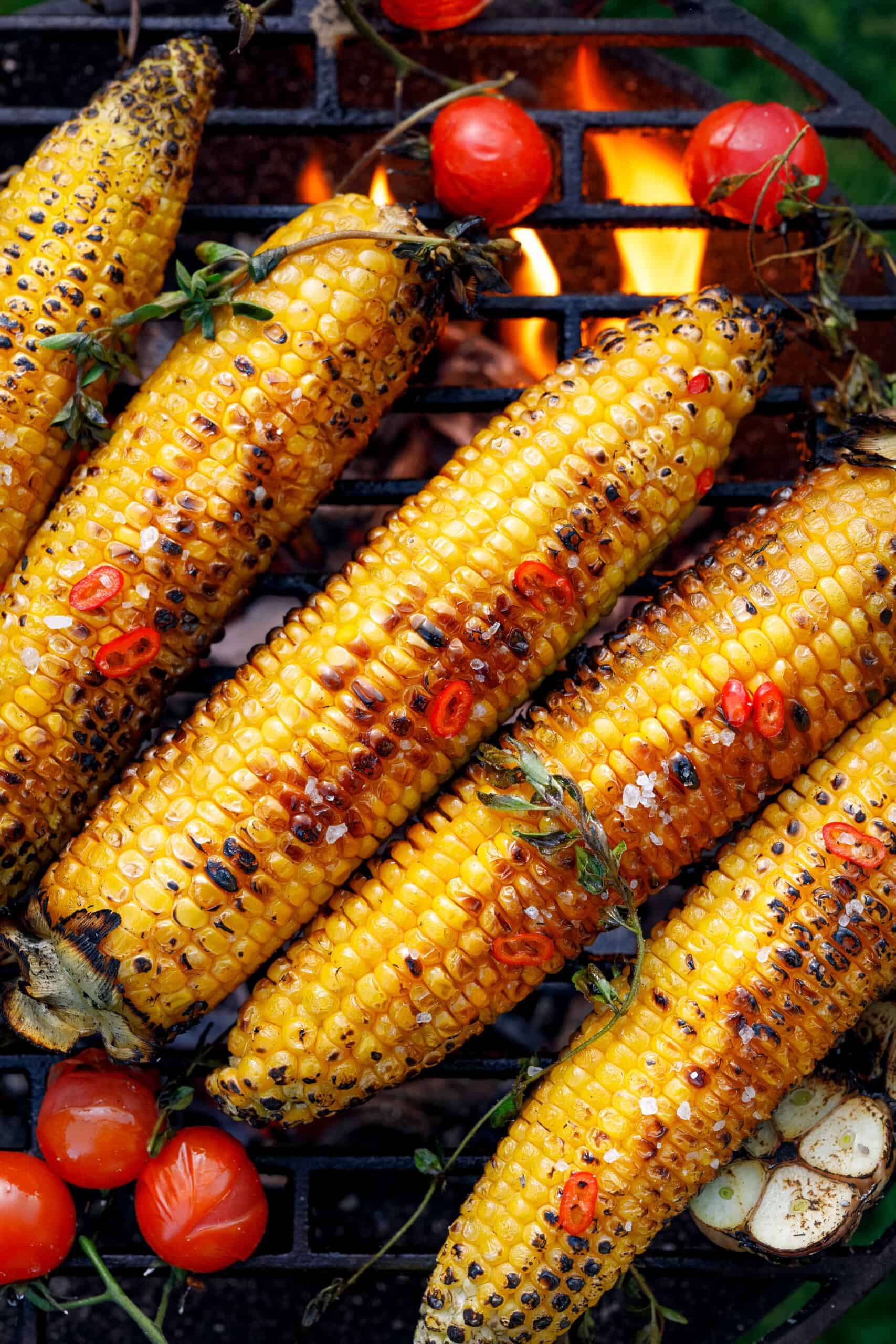
How to grill or roast corn on the cob
- Husk the corn and remove the silk.
- Smooth the husks back over the ears. (Salt and pepper before replacing the husks, if you like.)
- Heat the grill until moderately hot. If roasting, turn the oven to 500 degrees F.
- Put the rack about 4 inches from the heat.
- Grill or roast the corn, turning occasionally until the kernels are lightly browned, about 10 to 20 minutes.
- Serve with salt, pepper, and butter to taste.
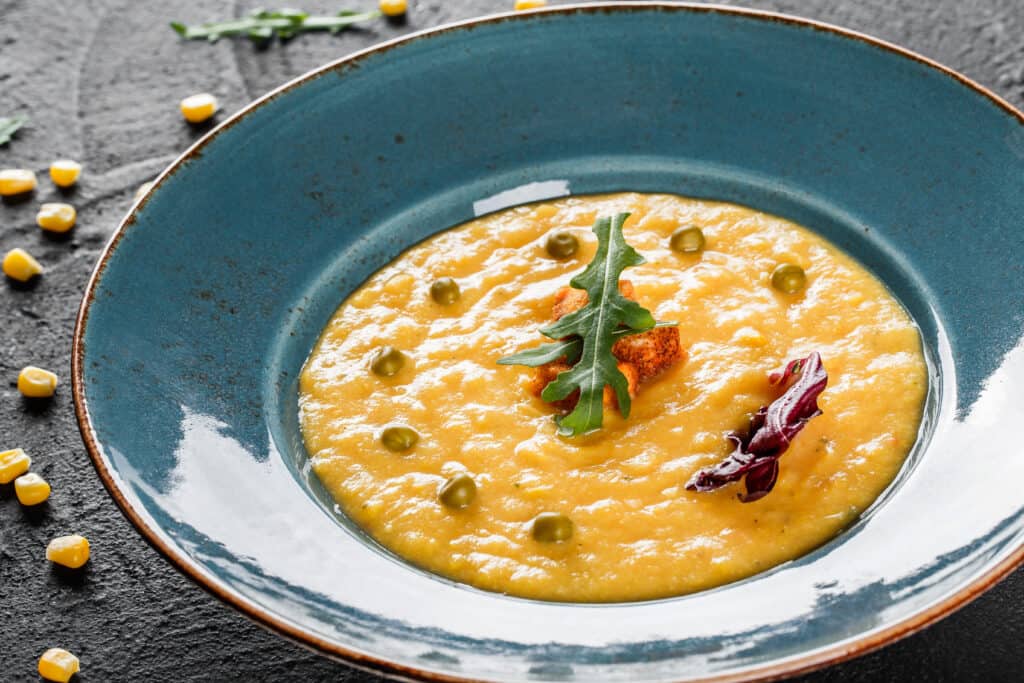
How to make creamed corn
- Shuck the corn and strip the kernels into a bowl (6 ears, about 6 cups)
- Melt butter in a skillet or broad saucepan over medium heat.
- When the butter foams, add the corn and cook stirring for two minutes.
- Add 1½ cups cream and bring to a gentle simmer.
- Add a pinch of salt and pepper and simmer until the corn is tender about 10 minutes.
- Continue to cook a few minutes more until the mixture is thick; add a bit of sugar if you like. Add additional cream if needed.
- If you want to thicken the mix, add a tablespoon of cornstarch and a tablespoon of water.
How to microwave corn on the cob
- Cook the corn in the husks for about 3 minutes on full power.
How to prepare raw corn
- Cut the kernels from the cob and blend with lightly whipped heavy cream; season with salt and freshly ground black pepper.
Corn flavor partners
- Corn has a flavor affinity for basil, beefsteak tomatoes, butter, clams, crab, eggs, fish, lobster, red onion, shrimp, and tarragon.
- Season cooked corn with salt or pepper.
Corn nutrition
- Corn contains modest amounts of vitamins A and B, potassium, and fiber.
- A 5-inch (13 cm) ear of corn has between 70 and 85 calories.
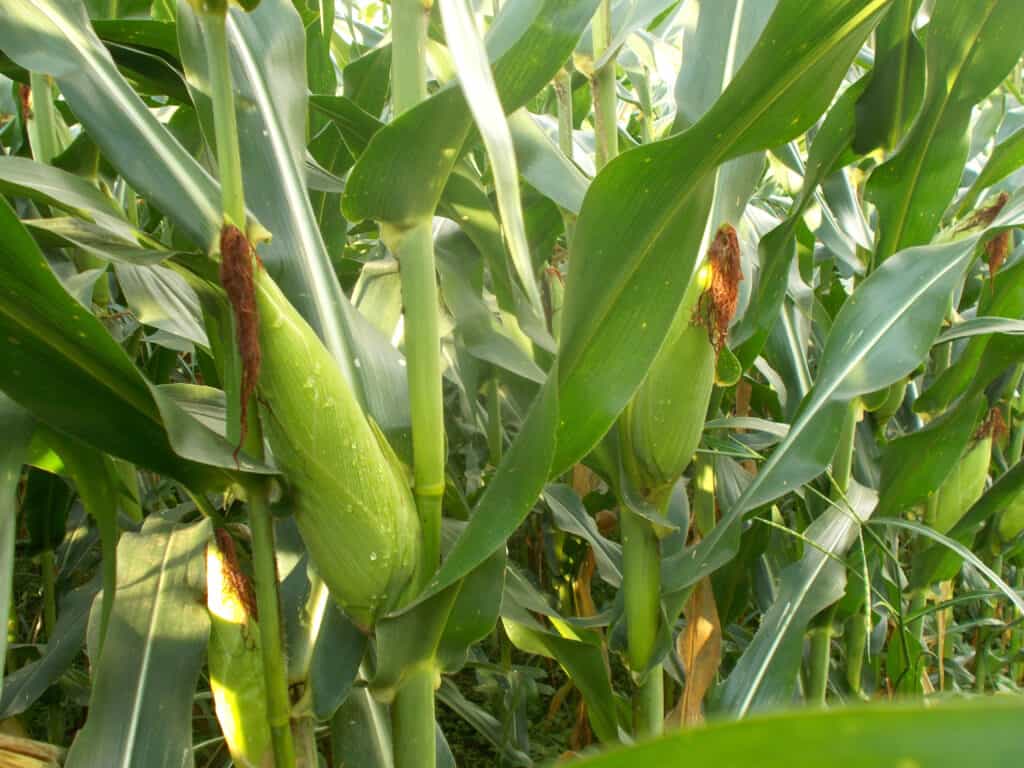
Get to know corn
- Corn—which is also called maize—is not technically a vegetable, but a grass. It is certainly one of the most popular foods to have originated in the New World.
- The top of a corn stalk terminates in a flowering plume or tassel which is the pollen-producing male flower. The pollen is carried by the wind and pollinates silky thread-like female flowers called silks or styles on ears lower down the stalk. Each of the silks is connected to an under-fertilized kernel. The lower ears develop as many full kernels as the number of silks that are pollinated. Kernels of sweet corn can be yellow, white, black, red, or a combination of colors. An ear of corn contains between 750 to 1,000 kernels.
- Corn originated in Central America and is thought to have been first cultivated in Mexico around 7,000 B.C. The Mayans and Aztecs bred and raised corn. Corn for cultivation spread throughout North and much of South America by 800 A.D.
- New World explorers brought corn to Europe in the sixteenth century.
- Corn is called corn in North America, but in much of the world, corn is called maize which is derived from the early American Indian word mahiz.
The botanical name for corn is Zea mays var. rugosa.
Corn articles at Harvest to Table:
How to Plant and Grow Sweet Corn
How to Harvest and Store Sweet Corn
Seven Ways to Cook and Serve Sweet Corn
Corn Chowder and Summer Flavors
Grilled Corn with Seasoned Butter
Baby Corn Cooking and Serving Tips
Corn, Beans, Squash: The Three Sisters
Corn Growing Problems Troubleshooting
Corn Earworm Organic Pest Control
Articles of interest:
Best Herbs for Container Growing
Garden Planning Books at Amazon:
- Vegetable Garden Almanac & Planner
- Kitchen Garden Grower’s Guide Vegetable Encyclopedia
- Vegetable Garden Grower’s Guide
- Tomato Grower’s Answer Book
More kitchen tips:
Bring your harvest to the table. Kitchen prep tips and easy recipes for the vegetables you grow. Click below for vegetable prep and recipes you can use now.
- Almonds
- Apples
- Apricot
- Aprium
- Artichoke
- Arugula
- Asparagus
- Avocado
- Bamboo Shoots
- Banana
- Basil
- Beans, Dried
- Beans. Long
- Beans, Shell
- Beans, Snap
- Beets
- Bitter Melon
- Blackberry
- Bok Choy
- Broccoli
- Broccoli Raab
- Brussels Sprouts
- Cabbage
- Cardoon
- Carrots
- Cauliflower
- Celeriac
- Celery
- Chard
- Chayote Squash
- Cherimoya
- Cherries
- Chestnut
- Chickpea
- Chinese Cabbage
- Chives
- Cilantro
- Citron
- Clementine
- Collards
- Coriander
- Corn, Sweet
- Corn, Baby
- Corn Salad, Mache
- Cranberry
- Cress
- Cucumber
- Daikon
- Dandelion
- Dill
- Eggplant
- Endive, Belgian
- Endive and Escarole
- Fava Beans
- Fig
- Florence Fennel
- Garlic
- Ginger
- Grapefruit
- Grapes
- Guava
- Horseradish
- Jerusalem Artichoke
- Jicama
- Jujube
- Kale
- Kiwifruit
- Kohlrabi
- Kumquat
- Leeks
- Lemongrass
- Lemons
- Lettuce
- Lime
- Mache (Corn Salad)
- Mandarin Orange
- Mango
- Maple Syrup
- Marjoram
- Melons
- Michihili
- Mint
- Mizuna
- Mushrooms
- Mushrooms, Cremini
- Mustard Greens
- Napa Cabbage
- Nectarine
- Okra
- Olives
- Olive oil
- Onions
- Oranges
- Oregano
- Parsley
- Parsley Root
- Parsnips
- Passion Fruit
- Pawpaw
- Peaches
- Pears
- Peas, Garden Snap
- Peas, Snow
- Pei Tsai
- Peppers, Chili
- Peppers, Sweet
- Persimmon
- Pineapple
- Pineapple Guava
- Plantain
- Plums
- Pluots
- Pomegranate
- Potatoes
- Prickly Pear
- Pumpkin
- Quince
- Radicchio
- Radishes
- Raspberries
- Rosemary
- Rhubarb
- Rutabaga
- Sage
- Salsify
- Sauerkraut
- Savory
- Shallots
- Sorrel
- Spinach
- Squash, Summer
- Squash, Winter
- Strawberries
- Sunchokes
- Sunflower
- Sweet Potato
- Swiss Chard
- Tangerine
- Taro
- Tarragon
- Thyme
- Tomatillo
- Tomato
- Turnip
- Turnip Greens
- Yams


